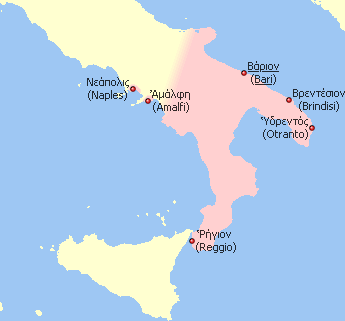Catepanate of Italy: Difference between revisions
m + interwiki pl |
mNo edit summary |
||
| Line 45: | Line 45: | ||
*[[Byzantine Empire]] |
*[[Byzantine Empire]] |
||
*[[Normans]] |
*[[Normans]] |
||
*[[Magna Graecia]] |
|||
[[Category:999 establishments]] |
[[Category:999 establishments]] |
||
Revision as of 17:40, 26 January 2008

The Catapanate (or Catepanate) of Italy was a province of the Byzantine Empire, comprising mainland Italy south of a line drawn from Monte Gargano to the Gulf of Salerno. Amalfi and Naples, although north of that line, maintained allegiance to Constantinople through the catapan.
In 876, the Byzantines retook Bari from the Saracens. They established the theme of Langobardia Minor by means of officers entitled first strategoi: one in Calabria and one in Apulia. The latter had its capital at Bari. In 999, the strategos of Bari was raised to the title of Catapan, or Patrician, of Italy. The title of katepano meant "the uppermost" in the Greek language.
Some Norman adventurers, on pilgrimage to Monte Sant'Angelo sul Gargano, lent their swords in 1017 to the Lombard cities of Apulia against the Byzantines. From 1016 to 1030 the Normans were pure mercenaries, serving either Byzantines or Lombards, and then Sergius IV of Naples, by installing the leader Ranulf Drengot in the fortress of Aversa in 1030, gave them their first pied-à-terre and they began an organized conquest of the land. In 1030 there arrived William and Drogo, the two eldest sons of Tancred of Hauteville, a petty noble of Coutances in Normandy. The two joined in the organized attempt to wrest Apulia from the Byzantines, who by 1040 had lost most of that province. Bari was reduced (April 1071) and the Byzantines finally ousted from southern Italy. They returned briefly to besiege Bari in 1156.
The title Catapan of Apulia and Campania was revived briefly in 1166 for Gilbert, Count of Gravina, the cousin of the queen regent Margaret of Navarre. In 1167, with his authority as catapan, Gilbert forced German troops out of the Campania and compelled Frederick Barbarossa to raise the siege of Ancona.
Catapans
- 999 – 1006 Gregory Tarchaneiotes
- 1006 – 1008 Alexius Xiphias
- 1008 – 1010 Ioannes Curcuas
- 1010 – 1016 Basil Mesardonites
- 1017 Leo Tornikios Kontoleon
- 1017 – 1027 Basil Boioannes
- 1027 – 1029 Christophoros Burgaris
- 1029 – 1031 Pothos Argyrus
- 1031 – 1033 Michael Protospatharios
- 1033 – 1038 Constantinos Opos
- 1038 – 1039 Michael Spondyles
- 1039 – 1040 Nicephorus Doukeianos
- 1040 – 1041 Michael Doukeianos
- 1041 – 1042 Exaugustus Boioannes
- 1042 Synodianos
- 1042 George Maniaces
- 1042 Pardos
- 1042 – 1045 Basil Theodorocanus
- 1045 – 1046 Eustathios Palatinos
- 1046 – 1049 John Raphael
- 1051 – 1057 Argyrus
- 1060 – 1061 Miriarch
- 1061 – 1062 Maruli
- 1062 – 1064 Sirianus
- 1067 – 1069 Mabrica
Sources
- This article incorporates text from a publication now in the public domain: Chisholm, Hugh, ed. (1911). Encyclopædia Britannica (11th ed.). Cambridge University Press.
{{cite encyclopedia}}: Missing or empty|title=(help) - Gay, Jules. L'Italie méridionale et l'empire Byzantin. Burt Franklin: New York, 1904.
- Norwich, John Julius. The Normans in the South 1016-1130. Longmans: London, 1967.
